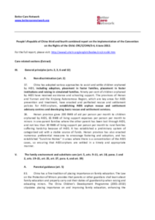The People’s Republic of China issued its third and fourth combined report on the implementation of the Convention on the Rights of the Child in June 2012, which is due to be examined by the Committee on the Rights of the Child at its 64th Session, taking place from 16 September to 4 October 2013 in Geneva.
Among information provided by the Government of China relating to children’s care, including sections addressing Family Environment and Alternative Care, the following is noteworthy:
- In December 2007, the National Information System for Orphaned and Handicapped Children was initiated, and relevant information is being steadily updated and input. According to the statistics, by the end of December 2009, there were a total of 712,000 orphans, of which 90,000 were in institutional care and 622,000 were living in individual households in the community.
- Currently, nationwide there are a total of 290 specialized children’s welfare agencies and 800 general welfare agencies with children’s departments, which have taken in a total of 90,000 orphans and abandoned infants.
- Over 80 per cent of children provided for by children’s welfare agencies have disabilities and are difficult to place for adoption by families. China has been transforming from a simple child-raising model to a multi-functional model that includes child-raising, medical care, special education and rehabilitation, as well as aspects such as skills training.
- Nationally, there are over 430,000 parent schools of different types, and over 110,000 community-based family education guidance centres.
- innovative substitute care models have been adopted. First, actively choosing for orphans and abandoned infants families who wish to adopt, who are caring and whose conditions are right. Second, placing children who are under the care of civil administrative departments in foster families. Third, forming relatively independent and stable small family units within children’s welfare organizations, with hired “parents” looking after the orphans and abandoned infants.
- China periodically reviews the settlement of disadvantaged children such as orphans and those with disabilities. In 2005, the Ministry of Civil Affairs conducted a general survey of the circumstances of orphans nationwide. The results of the survey demonstrated that the total number of children whose parents were both dead and who in practice had no-one to bring them up was 573,000, of whom 363,000 orphans received different degrees of relief through government institutions, and nearly 10,000 orphans received relief through non-governmental charitable organizations.
- In the aftermath of the Wenchuan earthquake in Sichuan on 12 May 2008, the Chinese Government put forward the requirements regarding the rescue and settling of orphans, including that orphans’ identity be confirmed as quickly as possible, and that various methods for long-term settlement of orphans be adopted, such as supervision by relatives, adoption by families, placement in foster families, and raising in simulated families or foster institutions.
- According to the 2006 National Sample Survey on Disability, China has 5.043 million children with disabilities, constituting 6.08 per cent of the disabled population as a whole.
- With regard to the education of children with disabilities, according to the Second National Sample Survey on Disability, there were 2.46 million school-age children between the ages of six and 14 with disabilities, of whom 63.19 per cent were receiving compulsory education, either in ordinary schools or in special education schools. By the end of 2009, there were a total of 1,672 special education schools, with 428,100 children with various disabilities attending school.
- China has stepped up its investment in providing relief to vagrant children. In May 2004, the Ministry of Civil Affairs allocated RMB 30 million to fund the construction of 84 institutions for the relief and protection of vagrant children.
To strengthen the institutional framework, a series of compulsory industry standards have been rolled out, such as:
- The Provisional Measures for the Management of Social Welfare Agencies, and the Basic Standards for Children’s Social Welfare Agencies;
- The Measures for Management of Family Foster Care (2003) make provision regarding aspects such as the choice of foster families, the fostering process, and standards of care;
- The Opinions on Strengthening Orphan Rescue Work (2006) require that departments put in place preferential policies in regard to nine aspects including orphans’ daily lives, medical treatment, rehabilitation and education;
- The Circular on Formulating the Minimum Subsistence Standard for Raising orphans, rolled out in February 2009 by the Ministry of Civil Affairs, determines that the minimum subsistence standard for the raising of those orphans in individual households should be 600 RMB per person per month.
- Guiding Opinions on Formulating the Minimum Subsistence Standard for Raising Children in Welfare Agencies, which recommends that the minimum subsistence standard for raising children in social welfare agencies should be 1000 RMB per month.

